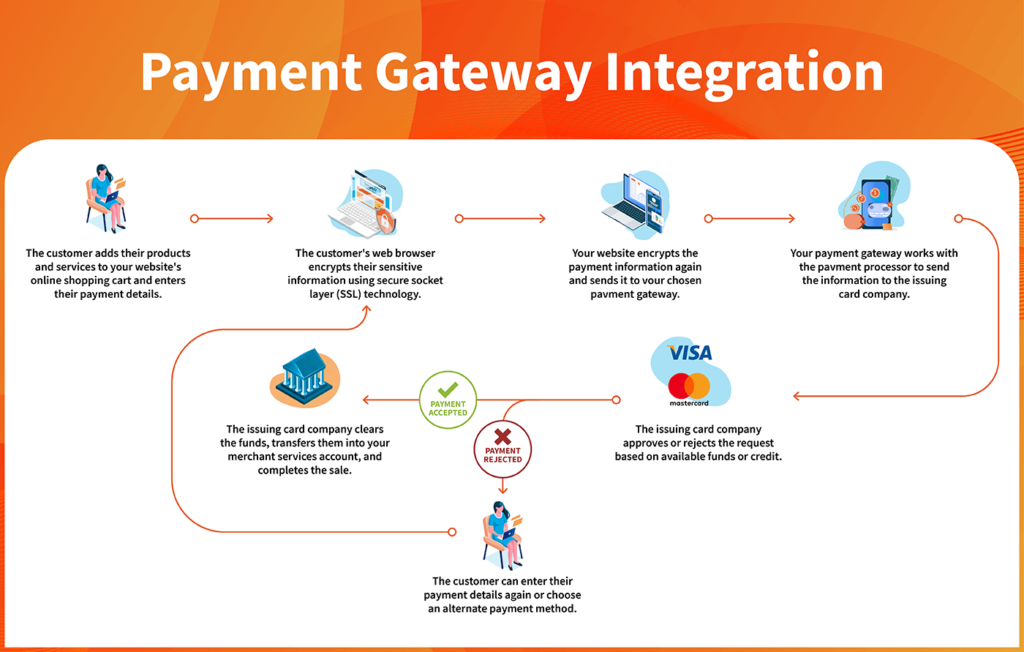AUTHOR : ANNU CHAUHAN
DATE : 31-08-2023
In today’s digital age, where online transactions have become a way of life[1], having a seamless and secure[2] also payment gateway integration[3] on your website is paramount. Whether you’re running an e-commerce[4] store, a subscription-based service, or even accepting donations, an efficient payment gateway[5] can make or break your user experience. In this article, we’ll delve into the intricacies of website payment gateway integration, exploring its benefits, the integration process, and the top considerations to keep in mind.
Introduction
In the digital landscape, where convenience and speed reign supreme also, integrating a payment gateway into your website is a vital step towards providing a smooth and hassle-free experience to your customers. This article will guide you through the process of integrating a payment gateway and shed light on its significance in the online business realm.

Understanding Payment Gateways
A payment gateway acts as a bridge between your website and also the financial institutions that process the online payments. It facilitates the secure transfer of sensitive payment information, such as credit card details, between the customer and the merchant.
The Importance of Integration
The integration of a payment gateway is not merely a technical requirement but a crucial aspect of user experience. A poorly integrated gateway can lead to frustrations, cart abandonments, and loss of customer trust.
Types of Payment Gateways
There are several types of payment gateways available, each catering to different business needs:
Hosted Payment Gateways
Hosted gateways redirect customers to a third-party page to complete the payment process. While this is simple to set up, it may redirect users away from your site.
Self-Hosted Payment Gateways
Self-hosted gateways offer more control over the payment process, but they require SSL certification and adherence to security regulations.
API-Hosted Payment Gateways
API-hosted gateways allow you to customize the payment process entirely, giving you control over the look and feel while handling security aspects.
Key Steps to Integrate a Payment Gateway
Choosing the Right Payment Gateway
Before integration, research and select a payment gateway that aligns with your business model and target audience.
Registering and Setting Up an Account
Create an account with the chosen payment gateway provider, providing accurate business and banking information.
API Integration
Integrate the payment gateway’s API into your website, allowing it to communicate with the gateway’s servers.
Testing the Integration
Thoroughly test the payment process with small transactions to ensure accuracy and security.
Going Live
Once testing is successful, take your payment gateway live and monitor its performance closely.
Ensuring Security and Compliance
Security is paramount in payment gateway integration. Obtain an SSL certificate to encrypt data and adhere to PCI DSS compliance standards to protect sensitive information.
Factors to Consider During Integration
User Experience
A seamless and intuitive payment process enhances the user experience and encourages repeat transactions.
Currencies and International Transactions
If your business operates globally, consider supporting multiple currencies and international payment methods.
Mobile Responsiveness
Ensure that the payment gateway is mobile-responsive to accommodate users on various devices.
Benefits of Seamless Payment Integration
Enhanced User Trust
A secure and hassle-free payment process builds trust and credibility among your customers.
Reduced Cart Abandonment
A complex or extended payment procedure can result in customers abandoning their shopping carts. A seamless integration reduces this risk.
Better Financial Management
Payment gateways offer features for tracking transactions and managing cash flow efficiently.
Challenges and Troubleshooting
Technical Glitches
Technical issues may arise during integration. Work closely with your payment gateway provider to resolve these promptly.
Payment Failures and Disputes
Address payment failures and disputes promptly to maintain customer satisfaction.
Future Trends in Payment Gateways
The future holds exciting possibilities, including biometric authentication, AI-driven fraud detection, and expanded cryptocurrency support.
Conclusion
In the fast-evolving world of e-commerce, website payment gateway integration stands as a crucial driver of customer satisfaction and business success. By following the steps outlined in this article, you can seamlessly incorporate a payment gateway that enhances user experience, builds trust, and propels your online venture towards prosperity.
FAQs
- Is it necessary to have an SSL certificate for payment gateway integration? Yes, an SSL certificate ensures the encryption of sensitive payment data, enhancing security.
- Can I use the same payment gateway for international transactions? Many payment gateways support international transactions, but ensure the chosen gateway aligns with your global business needs.
- What should I do if a customer faces a payment failure but the amount gets deducted? Promptly address the issue by reaching out to your payment gateway provider and resolving the problem in collaboration.
- Are there any alternatives to traditional payment gateways? Yes, alternatives like digital wallets and cryptocurrencies are gaining popularity, offering different payment methods.
- Where can I learn more about the payment gateway options for my website?






